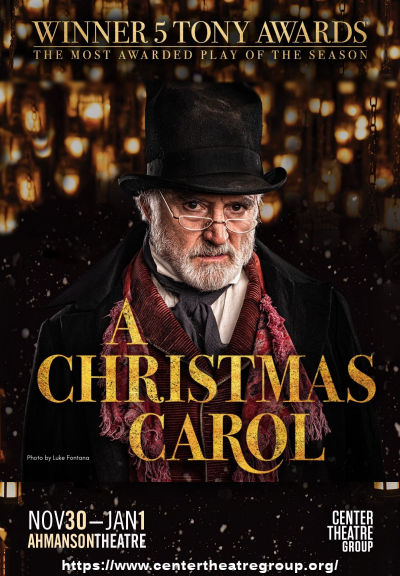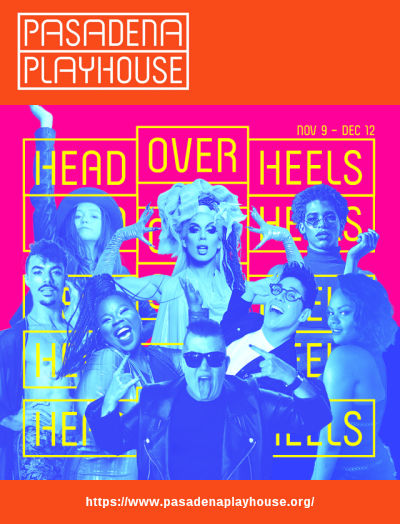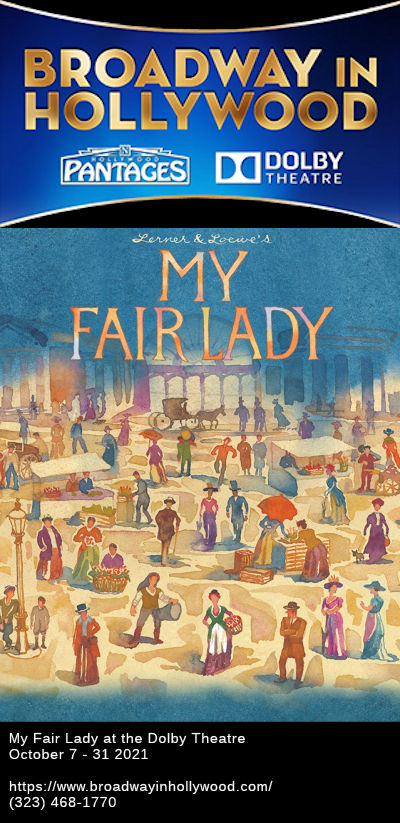
 Charles McNulty said he might be cast as the Scrooge of Drama Critics, and I’ll gladly cast him as such. How he let a technical problem at his performance mar his enjoyment of this delightful version of A Christmas Carol at the Ahmanson Theatre (FB) is beyond me. “Bah Humbug” to you sir; this is a very Happy Christmas Carol indeed.
Charles McNulty said he might be cast as the Scrooge of Drama Critics, and I’ll gladly cast him as such. How he let a technical problem at his performance mar his enjoyment of this delightful version of A Christmas Carol at the Ahmanson Theatre (FB) is beyond me. “Bah Humbug” to you sir; this is a very Happy Christmas Carol indeed.
Now, I’m a Jewish boy. I’m not a big fan of the heavy emphasis that Christmas gets (I tend to agree with Stan Freberg’s Green Chri$tma$). I used to be tired of A Christmas Carol; indeed, some versions are very tiresome. My favorite production of the story is still A Mulholland Christmas Carol (which needs to be brought back), and I’m partial to the audio version of the Christmas Carol concert by Alisa Houser and Bob Christianson. It was that version from which I learned the fuller version of the story; previously, it was just remembered snippets from the various TV movie versions.
So what about the version of A Christmas Carol that is currently playing at the Ahmanson. The Old Vic production that was on Broadway just before the pandemic shut everything down. The one where Jack Thorne adapted Charles Dickens‘ version of the story (although Mr. Dickens doesn’t get a credit in the program — the man needs a new agent). The one that was originally conceived and directed by Matthew Warchus. The one that won 5 Tony Award in the Tony Award Season with an Asterisk. You know, that Christmas Carol.
Well, despite what McNulty said, I enjoyed it quite a bit. The stage craft was astounding, the performances delightful. At was at times dark, at times joyous, and at times laugh out loud funny. This wasn’t one of those dour versions of the story, where the actors are tired and the story comes across the same. The actors behind this production were clearly having fun with the story, and that fun came through in the performances. They, in the words of the play, had Christmas in their hearts.
Thorne took some liberties with the story. He played up the roles of Fan and Belle, bringing them much more into the latter parts of the story than is traditional. He dropped some elements that still remain in my head: the dances at Fezziwigs, the children that accompany the Ghost of Christmas Present. He gave a face to the Ghost of Christmas Future when it was just a spectre before (which made for better theatre). He made Scrooge’s father a more pivotal figure, perhaps to provide more of a backstory. He brought the party to the Cratchett’s in a way I haven’t seen before. But you know what? It worked. I remarked to my daughter afterwards that A Christmas Carol is a lot like a Passover Seder. There are elements that absolutely must be in the story, and there is a trajectory to the main characters that must achieve the same resolution. But the surrounding elements can be adjusted slightly, and symbols can be adapted, to emphasize points relevant to the audience. That’s what this Carol did: the emphasize was a clear message that although the past can shape our behavior, it is we who have the free will to change our destiny. We can choose joy and caring about others; or we can only care about ourselves and what is in it for (as Paul Stookey might say), “Meeeeeeeeeeeeeeeeeee”.
Although this adaptation was done before the pandemic, that message—the importance of caring about others and doing things to make their lives better, and not being self-centered—clearly resonates even more in the first production at the Ahmanson after COVID. As Bradley Whitford notes at the ending bows, this production is possible thanks to those who listened, cared about others, and took the steps necessary to make theatre safe again. That means they go their shots. What better way to have Christmas in your heart, and carry Jesus’ message about caring for the least, than making sure you protect them by getting vaccinated. It’s a great gift, and it’s free as well. Scrooge would approve.
This production also has some wonderful localized humor. After Scrooge’s transformation, when he’s gathering food for the eventual feast, the writers throw in a number of local references and lots of ad-libbing. It’s delightful, and brings the audience in on the action. There are a number of other wonderfully immersive elements, from the actors tossing fruit to the audience before the show, to the lighting of the piece, to the snow in the theatre, to the actors showing up not just around the orchestra level, but up in the Mezzanine and the Balcony. It’s hard not to walk out of this production with a smile on your face (well, unless your Charles McNulty).
Would I recommend this production? Wholeheartedly yes. It was a load of fun.
One thing that made this production special is that it is clear that the actors are enjoying themselves, and are having fun with their role. No where is that seen better than with the lead, Bradley Whitford Ebenezer Scrooge . Typically, Scrooge comes across as dour. Whitford starts out that way, but there’s a glimmer of something mischievous in him. Not in the way he is with money, but in the quick-witted responses he makes. It is clear he finds himself funny, even if no one else does. The other thing I noted about Whitford is how he disappeared into his character. I watched the recent Annie Live! on NBC, and everyone was praising Ann Dowd‘s performance as Charlotte Rae as Mrs. Garret. But when I saw it, I kept seeing mannerisms that made me think of Aunt Lydia. Bradley Whitford is also in Handmaid’s Tale, but there was no trace of Commander Lawrence in his portray of Scrooge. Whitford was a believable Scrooge.
Another notable performance—and one I was looking forward to—was that of Alex Newell Ghost of Christmas Present / Mrs. Fezziwig.* Newell has a wonderful voice, and they got the opportunity to use it at various points in the program. But what made Newell’s performance wasn’t the singing—it was their smile. From the opening playfulness with the audience to the end, whenever Newell would smile the world would light up in joy. That joy fed back into the performance, with Newell being a wonderful Ghost of Christmas Present, as well as numerous other characters. They were having loads of fun, and it showed.
*: Newell used he/him in the program, but has indicated they don’t really have a preference. They are gender non-conforming, and has indicated that people should use whatever is comforatable. My mind says she/her, so I’m going with they/them as a middle ground.
Also notable was Kate Burton Ghost of Christmas Past. She had a bit more of a reserved role with an odd face mask, although she seemed to loosen up in the post-transformation sequences.
Completing the ghosts, the adaptation placed Glory Yepassis-Zembrou Little Fan as the voice of the Ghost of Christmas Future. This changed worked in the revised story, and she made a believable sister to Scrooge.
The other characters, although having named roles, served more as a supporting ensemble to the leads: Chante Carmel Mrs. Cratchit; Dashiell Eaves Bob Cratchit; Brandon Gill Fred; Evan Harrington Fezziwig; Chris Hoch Father / Marley; Sarah Hunt Belle; Alex Nee Ferdy / Nicholas; Cade Robertson Tiny Tim; Brett Ryback George; Harry Thornton Young Ebenezer; Grace Yoo Jess. Sebastian Ortiz Alternating as Tiny Tim. Standbys were Andrew Mayer and Celia Mei Rubin. Some notes on the supporting ensemble: Gill was actually up near us in the Mezzanine during the food gathering sequence, and he was fun to watch as he reacted to Whitford’s seeming ad-libs. I liked Hunt’s Belle, who had a nice inner spirit, and Hoch had a spectacular voice. Cade Robertson was incredibly cute as Tiny Tim; more notable is that the casting notice specifically cast disabled performer in the Tiny Tim role. Representation is everything, especially when you’re blessing everyone.
Although this wasn’t a musical, there was a fair amount of music. This was mix of background and mood setting instrumentals, traditional Christmas music with some modified arrangements, and some new pieces composed and orchestrated by Christopher Nightingale. Music was provided by a mix of on-stage and off-stage performer, a number of whom were part of the acting ensemble (🎻). The musician team consisted of Remy Kurs Music Director / Keyboard; Alonso Pirio Assoc. Music Director; 🎻 Evan Harrington Drum; 🎻 Brett Ryback Whistles / Accordion; Hillary Smith Cello; 🎻 Harry Thornton Cello / Bass; Mona Tian Violin; Micah Wright Clarinet / Bass Clarinet / Whistles; 🎻 Grace Yoo Ukulele. The rest of the music staff consisted of Howard Jones Music Coordinator; Emily Grishman Music Preparation Music Copying; Paul Staroba Music Supervision; Randy Cohen / Randy Cohen Keyboards Synthesizer Technician.
Turning to the production side: The performance was originally directed by Matthew Warchus; with Thomas Caruso being responsible for tour direction. Lizzi Gee coordinated the movement. A few thoughts on the production design. This cast consisted of about 40% veterans of the Broadway production, and the rest who were new to the show for Los Angeles and a few other cities. The director did a great job of making this a unified team, and bringing out remarkable performances in the Los Angeles local team (who do a lot of work for cameras, not large rooms of people). Additionally, although A Christmas Carol may be technically a straight play, there is lots of movement and choreography, and Gee made it poetic and seamless and delightful to watch.
The most remarkable aspect of the production, however, was on the stagecraft side. Let’s start with what hits you when you walk to your seats: Hugh Vanstone‘s lighting design. Thousands of lanterns throughout the theatre; lanterns that you learn are programmed and not just mere lights (and so credit should go to Craig Steizenmuller US Assoc Lighting Designer; Sam Waddington UK Assoc Lighting Designer; Joe Beumer Asst Lighting Designer, and the Moving Light programmers Alyssa Eilbott and Mo Epps). Combine this with the other remarkable lighting that sets the mood, and you’ll be blown away (and this includes lighting the audience at times). The second remarkable aspect of the program is the sound design. Rob Howell‘s set is simple: a basic wooden cross, some boxes that can be moved around, and four doorframes that rise up and down. It is Simon Baker‘s sound design that brings this to life. The actors pretend to open the door; and the sound makes it real. They slam the door; sound makes it real. The sound becomes the props, and you see the difference between the imagination that stagecraft can create vs the realism that film demands. The remainder of the scene was set by Rob Howell‘s costumes and the work of the team from Campbell Young Associates Wigs, Hair, & Makeup Design. The principle designers were augmented by Michael Carnahan US Assoc Scenic Designer; Nancy A. Palmatier US Assoc Costume Designer; Andrew Wade Voice and Dialect Director; and Kathy Fabian / Propstar LLC Props Supervisor.
Rounding out the production team were: Jim Carnahan CSA Casting; Jason Thinger Casting; David S. Franklin Production Stage Manager; Michelle Blair Stage Manager; Amy Ramsdell Stage Manager; Showtown Theatricals General Manager; Aurora Productions Production Management. I always give credit to the COVID Safety Teams, for without their work we would not be in the theatre. On the A Christmas Carol side, this was Swif Testing / Jeff Whiting COVID-19 Management; Sheree Devereaux COVID-19 Officer; and Krystal Nelson COVID-19 Medical Technician. On the CTG side, this is Niki Armato Facilities Assistant / COVID Compliance Officer; and a large team of supporting COVID compliance officers: Chase Anderson-Shaw, Monica Greene, Dean Grosbard, Henry Kelly, and Denise Reynoso.
A Christmas Carol continues at the Ahmanson Theatre (FB) through January 1, 2022. Tickets are available through the Ahmanson box office; discount tickets may be available through Goldstar.
❧
Ob. Disclaimer: I am not a trained theatre (or music) critic; I am, however, a regular theatre and music audience member (modulo the COVID break). I’ve been attending live theatre and concerts in Los Angeles since 1972; I’ve been writing up my thoughts on theatre (and the shows I see) since 2004. I do not have theatre training (I’m a computer security specialist), but have learned a lot about theatre over my many years of attending theatre and talking to talented professionals. I pay for all my tickets unless otherwise noted (or I’ll make a donation to the theatre, in lieu of payment). I am not compensated by anyone for doing these writeups in any way, shape, or form. I currently subscribe at 5 Star Theatricals (FB), Broadway in Hollywood (FB), the Ahmanson Theatre (FB), and we have a membership at The Pasadena Playhouse (FB). We were subscribing at Actors Co-op (FB) and the Musical Theatre Guild (FB) prior to COVID; they have not yet resumed productions. We have also been subscribers at the Soraya/VPAC (FB), although we are waiting a year before we pick that up again. Through my theatre attendance I have made friends with cast, crew, and producers, but I do strive to not let those relationships color my writing (with one exception: when writing up children’s production, I focus on the positive — one gains nothing except bad karma by raking a child over the coals). I believe in telling you about the shows I see to help you form your opinion; it is up to you to determine the weight you give my writeups. Note to publicists or producers reading this: here’s my policy on taking comp tickets. Bottom-Line: Only for things of nominal value, like Fringe.
Upcoming Shows:
For right now, we’re pretty much sticking with shows that come as part of our subscriptions or are of interest through our memberships. That may change later in 2022. Looking at the first half of 2022: January brings Everyone’s Talking About Jamie at the Ahmanson Theatre (FB). February brings Something Rotten at 5 Star Theatricals (FB) and Marvin’s Room at Actors Co-op (FB). March brings The Lehman Trilogy at the Ahmanson Theatre (FB), Trayf at the Geffen Playhouse (with the TAS Live Theatre group); and Ann at The Pasadena Playhouse (FB). April brings the Southern California Renaissance Faire; Hadestown at at the Ahmanson Theatre (FB) (although that may get pushed to May); and Tootsie at Broadway in Hollywood (FB). May is otherwise empty, but June will see Come From Away at the Ahmanson Theatre (FB) and Pretty Woman at Broadway in Hollywood (FB), plus as much of the Hollywood Fringe Festival as we have the energy for.
As always, I’m keeping my eyes open for interesting productions mentioned on sites such as Better-Lemons, Footlights, as well as productions I see on Goldstar, On Stage 411 or that are sent to me by publicists or the venues themselves. Want to know how to attend lots of live stuff affordably? Take a look at my post on How to attend Live Theatre on a Budget (although I know it is outdated and need to update it). Want to learn about all the great theatre in Southern California? Read my post on how Los Angeles (and its environs) is the best area for theatre in the Country (again, I need to review this for the post-COVID theatre landscape)!



 Silence. Calm. Space. Relaxation.
Silence. Calm. Space. Relaxation.
 Back in late 2018, I happened to listen to
Back in late 2018, I happened to listen to 
 And now two outings to post-pandemic theatre are done. This could get to be a habit.
And now two outings to post-pandemic theatre are done. This could get to be a habit. One of the things that makes this production stand out is its production values and staging. One of the things I like about Cabrillo/5-Star is that it truly lives up to its former slogan “Broadway in your Backyard”. They present Broadway-caliber shows, with Broadway production values, at the regional level. They draw upon top national talent for the leads (and top local talent), and have a great knack of identifying up-and-coming talent from the Southern California talent pool. This production, under the direction of well-known Southern California musical director
One of the things that makes this production stand out is its production values and staging. One of the things I like about Cabrillo/5-Star is that it truly lives up to its former slogan “Broadway in your Backyard”. They present Broadway-caliber shows, with Broadway production values, at the regional level. They draw upon top national talent for the leads (and top local talent), and have a great knack of identifying up-and-coming talent from the Southern California talent pool. This production, under the direction of well-known Southern California musical director 